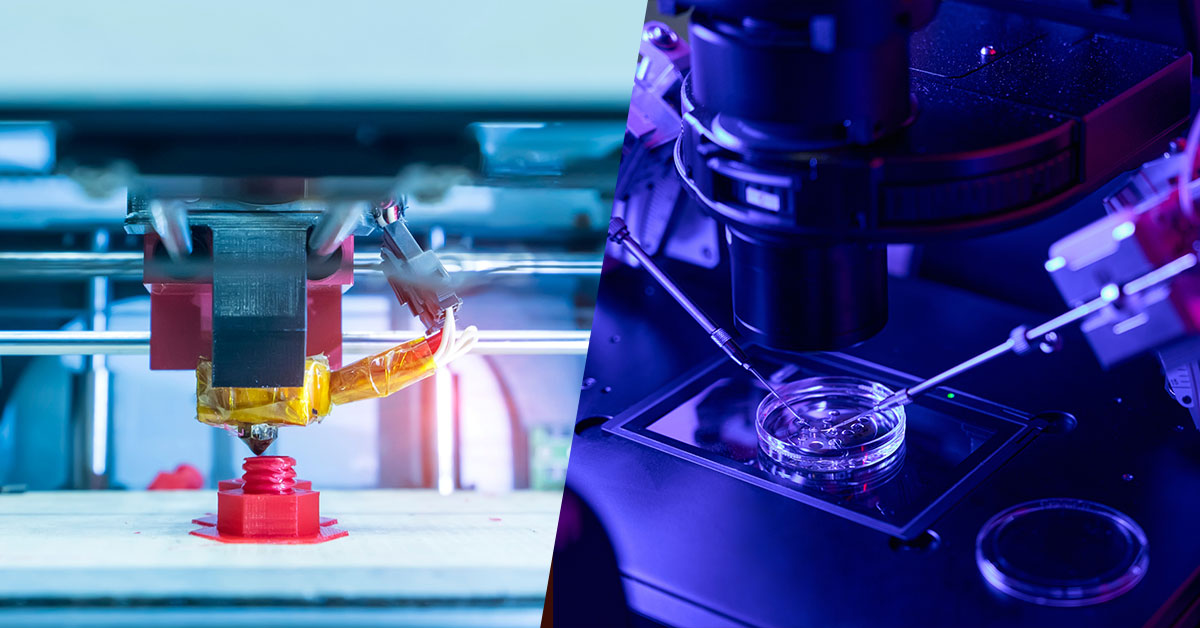3D Printing vs. Bioprinting: Understanding the Differences and Similarities

3D printing and bioprinting are two groundbreaking innovations that have captured widespread interest in the aspect of manufacturing and medical technologies. Although they sound similar, these technologies serve distinct purposes and are based on different principles. In this blog, we’ll take a look at what each technology is, how they differ, and where they overlap.
On This Page
- What is 3D Printing?
- How 3D Printing Works
- What is Bioprinting?
- How Bioprinting Works
- Key Differences Between 3D Printing and Bioprinting
- Similarities Between 3D Printing and Bioprinting
What is 3D Printing?
3D printing, also known as additive manufacturing, is a technology that creates objects layer by layer from a digital file. It’s revolutionizing industries from automotive to aerospace by enabling rapid prototyping and production of complex parts.
Related: The 5 Must-Know Benefits of 3D Printing
How 3D Printing Works
The process of 3D printing begins with a digital model, crafted using computer-aided design (CAD) software. This model is then sliced into thin layers by 3D printing software, guiding the printer to build up the object layer by layer using materials such as plastics, metals, ceramics, and even composite materials.
3D printers utilize various technologies, including:
- Fused Deposition Modeling (FDM): This method involves melting and extruding thermoplastic filament, which is deposited layer by layer.
- Stereolithography (SLA): A laser cures liquid resin into hardened plastic in a process known as photopolymerization.
- Selective Laser Sintering (SLS): This technique uses a laser to sinter powdered material into a solid structure.
Related: What are the Different Types of 3D Printing Methods?
What is Bioprinting?
Bioprinting is an advanced form of 3D printing that involves printing living cells to create biological structures. It’s a promising technology for medical applications, such as tissue engineering and regenerative medicine.
How Bioprinting Works
Bioprinting also starts with a digital model, but instead of plastics or metals, bioprinting involves bio-inks. These are mixtures of living cells, biomaterials, and growth factors. The bioprinting process typically involves:
- Designing the Model: Bioprinting starts with creating a digital model of the tissue or organ using CAD software or medical imaging data like MRI or CT scans, ensuring accurate detail for proper functionality.
- Choosing the Bio-Ink: Bio-Ink is a key component in bioprinting, containing living cells and biomaterials. Its composition depends on the type of tissue being printed and is designed to mimic the natural extracellular matrix, providing an environment for cells to thrive.
- Printing: The bioprinter deposits the bio-ink layer by layer, creating the tissue structure, which may require further cultivation and nourishment post-printing.
Key Differences Between 3D Printing and Bioprinting
Although both 3D printing and bioprinting use additive manufacturing principles, they differ significantly in applications and materials.
1. Materials Used
- 3D Printing: Common materials include thermoplastics (like PLA and ABS), metals, ceramics, and composites.
Related: 10 Common Materials Used in 3D Printing
- Bioprinting: Utilizes bio-inks composed of living cells, hydrogels, and other biomaterials designed to create viable biological tissues.
2. Applications
- 3D Printing: Found in manufacturing for rapid prototyping, creating complex parts, and producing customized products in industries such as automotive, aerospace, fashion, and electronics.
- Bioprinting: Primarily focused on medical applications, including creating tissue models for drug testing, developing tissue and organ structures for transplantation, and advancing regenerative medicine.
3. Technology and Complexity
- 3D Printing: The technology is mature, with a variety of off-the-shelf machines available for different types of 3D printing.
- Bioprinting: A more complex and evolving field, requiring sophisticated handling of living cells and precise control of biological environments.
Similarities Between 3D Printing and Bioprinting
Both 3D printing and bioprinting use additive manufacturing, building objects layer by layer from digital models. This process allows for the creation of complex geometries and efficient material use, reducing waste compared to traditional manufacturing methods.
1. Digital Design and Fabrication
These technologies rely on digital designs created in CAD software, allowing precise and accurate production. The use of digital files facilitates rapid prototyping, quick iterations, and efficient production processes.
2. Rapid Prototyping and Customization
3D printing and bioprinting are both capable of producing customized items quickly, making them valuable for rapid prototyping and producing personalized products. This is particularly useful in healthcare for patient-specific solutions and in consumer markets for customized products.
3. Integration with Advanced Technologies
Both fields are increasingly integrating with technologies like robotics, AI, and advanced materials, enhancing their capabilities and applications in various industries.
These shared characteristics underline how 3D printing and bioprinting are transforming manufacturing and healthcare through their additive manufacturing processes, customization abilities, and rapid prototyping benefits.
To conclude, 3D printing and bioprinting are both transformative technologies, each with its own unique applications and benefits. From creating complex components for aerospace to developing life-saving medical tissues, these cutting-edge technologies continue to push the boundaries of what’s possible, driving innovation and opening up new possibilities for the future.
Looking for quality 3D printing in the Philippines? Contact us today to learn more about our products!


